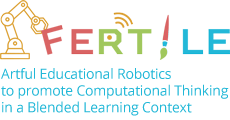Results
Learn more about the FERTILE project concrete objectives and results.
Objectives

FERTILE Project
The project’s concrete objectives are:
- to develop the FERTILE design methodology for Artful Educational Robotics (ER) projects that integrate face-to-face and online activities through ER simulators and remote collaboration,
- to develop the FERTILE community platform for educators to remotely collaborate,
- to develop training materials, including exemplar Artful ER projects as open educational resources for pre and in-service teachers and academic educators,
- to train pre and in-service teachers and academic tutors in the FERTILE design methodology towards implementing the methodology in their schools or university courses on ER and disseminating it to their colleagues aiming to create an educator community that will remain after the project ends.
1st Result
The 1st result focused on the 1st objective of the “FERTILE” project, i.e., developing the “FERTILE” design methodology to address digital transformation in teacher education.
The design methodology aims to assist educators in integrating Educational Robotics and Arts into their teaching practice in a blended learning context. It triggers the cultivation of 21st-century skills, focusing on students’ Computational Thinking.
2nd Result
The 2nd result contributed to the 2nd objective of “FERTILE” towards developing an educator community and serves as a means of disseminating all the other project results.
The community platform is the online place where educators and/or students meet remotely to collaborate, discuss, and share artefacts.
The “FERTILE” platform aims to support educators in designing and learners in implementing Artful ER projects.
3rd Result
The 3rd result contributed to the 3rd objective of the “FERTILE” project, i.e., to develop training materials, including exemplar Artful ER projects as open educational resources for pre- and in-service teachers and academic educators. The “FERTILE” Training Materials support a modular training structure and provide all the necessary content for activities taking place f2f and online.
The content developed includes individual, collaborative, and peer-review activities taking place face-to-face, synchronously or asynchronously, exemplar Artful ER projects, presentations (PowerPoint or video), study material, and scientific papers web resources.
The main innovation of this result is the experiential training approach that the training scheme and content adopt, aiming to provide Artful ER experiences to the trainees-educators similar to those of their students.
The training materials are provided as open educational resources.
The modular structure of the materials allows for adaptations to different contexts related to the level of education, the variety of robotic technologies used at the primary/secondary/vocational/university level, and the forms of arts education (audiovisual, performing, literature) adopted in various educational curricula of the participating countries.
4th Result
The 4th result aimed at communicating the FERTILE results to pre-service teachers, in-service teachers, and academic tutors. This result addressed educators’ needs to go beyond classroom-based learning and face-to-face interaction by practising ER simulators and remote collaboration in a blended context toward digital transformation,
To this end, pilot studies for about 70 educators and training events for about 250 educators were organized. The duration of these events was about 20 hours, and the mode of delivery was blended involving f2f, synchronous and asynchronous sessions.
Reports on conducting the pilot and the main “FERTILE” training events are available as OERs to the educational community.
The model structure of a “FERTILE” training suggested, along with its complementary training materials, enables future organisations of training events.

